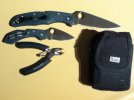I'm confused (please set me straight) -- it seems like the size of the crystal formed (along with its composition, of course) would have more to do with the alloy's hardness than the specific hardness of any one interstitial, yeah? We're talking micro- scale for individual
crystals (or grains, if you prefer) in the metal matrix - any one carbide is necessarily smaller than the crystal it habitates; how can we quantify any discrepancy between (or effect on) the hardness of the matrix and the carbide at the scale relevant to the blade's edge?
Also, there is lots of talk about 'large' vs. 'small' carbide formation (Cr vs. V, if I recall, is the frequent comparison) - is the carbide itself changing size (again, on a scale relevant to the knife blade), or is it a matter of carbide dispersal (or both)?
Thanks for the help!
*ref.:
https://www.google.com/url?sa=t&rct=j&q=&esrc=s&source=web&cd=2&cad=rja&uact=8&ved=0ahUKEwiz04D4pqnYAhUHzmMKHczCAJQQFggwMAE&url=https://www.researchgate.net/file.PostFileLoader.html?id=58208643f7b67e28620e7b7d&assetKey=AS%3A425785287811076%401478526531681&usg=AOvVaw2BcdZwXXixJyqfdNguAuGO






